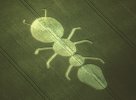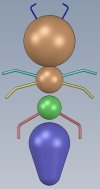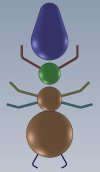Haiku
Jedi Master
Rambling of a Wandering Mind: Continuance of time on a mobius strip.
I am hoping that we all are able to see where we might be in the time cycle. Are we at the crest, it is a possibility? As far as I have read and understood, the universe is still expanding. So that means we are not exactly at some impending point of universe compression reversal, that is still ahead on this time curve. This brings us to our cluster of souls that we have here in this reality. I envision a gathering, possibly a galaxy in structure, where you have a spherical grouping that tapers off to a thinner edge. And out on the far edges lesser clusters of souls, with one major point. The structure needs to always be balanced. And by that, I mean there is an equal number of STS vs STO souls. For if the balance is otherwise, everything comes loose, like you are seeing today. Let me present this image of what I am implying here. It also helps with the explanation. You see this cross-section of a concept I was speaking of. This cluster (actually a side view of the milky way galaxy) has this vertical separation line in the middle of it signifying the separation between STO and STS orientations. Think of it as the midplane of this reality, like the 50% line. Those souls on the right are STO oriented and the opposing souls on the left are STS oriented. Our first subject, a STO oriented individual, with a STO orientation of 51%, just off center to the right, has an opposing STS soul at 51% to balance both souls in the structure. They would look like this on the plot. Now these two souls may even know each other and not even notice that they are opposing souls, balancing out this reality. Now I have a horizontal line in the image, that is for another representation in this main image. This line is the edge of reality that is connected to the time curve. I am going to place another line just above and mirrored below. These two lines signify the start of a different group of souls. Those souls that lie farther from this center horizontal line are less connected to the reality. I envision that this is where OP’s congregate. One item here that I have not worked out is what does it mean to be above the horizontal line to being below it. It may have a deeper meaning, but I do not know what that is yet. But back to our subjects. If you have another subject that is say 60% STO orientated, like this guy here then there is another opposing soul in the structure at 60% STS. The soul’s at each end are those that guide this reality. At all times, the balance needs to be maintained. Now onto just were I might fit myself into this mapping may be interesting.
My case is of other knowledge. I believe that I have seen my balancing soul. As many of you know I was given the honor of being one of many souls to see the STS contingency, up close and personal. This is my UFO encounter and getting to see the STS opposition through a portal on the craft, showing me the one in charge of it. I am contending that this soul, a STS Orion fourth or fifth density that I call my nemesis/friend, is my opposing soul in this reality. Where ever I am in this structure (suggesting that I am STO oriented), about here, but in reality, I could be anywhere in the thinner section toward the ends. And my opposing soul, my nemesis, is going to be weighted similarly in the STS structure. We balance each other out, maintaining this reality. You see those farther out in this structure have more influence in the balance, not by weight but by an orientation balancing effect.
So, what this means is there is an opposing you (soul) somewhere in this reality that balances this reality, or there needs to be. But unbeknownst to you, as your soul progress so does the opposing soul in opposition. Because of this state that this world is in, I would say that there are a great many of these soul oppositions that are off balanced to the STS side. And we need to keep up with our opposing soul, this is why there is this urgency, we need everybody to gain knowledge and STO orientation. Don’t let your opposing soul offset your balancing effect in this reality …
Rambling of a Wandering Mind, Side story2: Back door to your inner you.
This is a good one. The December 9, 2017 session started all of this one. I work with computers and programs every day. I always leave myself a back door to any computer or program that I utilize. I setup a system password that never changes. Something simple that I can use to fix or revise something. So why would I do any different in the programs in myself. I am positive that I left a back door in myself. This is like …
New movie out, Name Passengers. Good plot, high tech and so, it was an entertaining movie. But being an engineer, the thought of this trip across space without any failures was laughable. The first sleep pod that failed was through a component that did have a redundant system but still failed. In the plot of the movie, this had never happened. As an engineer, I would have had to put in the “Oop’s” button somewhere only an improperly woken individual would be able to push. Or you keep a minimal team awake, just for the trip, just in case, to attend to any unforeseen issues.
I think of this because of the back door thought direction. I would have put an oop’s button on the ship, a back door. I expect that I, and all others, have an oop’s button, a back door to programming, the inner you/me. An accessible point of entry.
Why do I want to find this back door? I am interested in editing my profile, loosen the tolerances a little. I want to turn off programs, decode them, to allow me to access these areas that I have turned off to come into this reality of third density. We are in a time of blending where third and fourth densities are one. I expect that this was in my life plan, to happen at some point in this reality because of the blending. Not just that but to work to help others, even more.
Now the concept is not one without alternate effects. If one does happen to open themselves up without the required effort, it might be like a grenade to your soul. There is much that you can connect to and if the effort is not properly done then you could drive yourself crazy. The first thing you will come in contact with is thought and how open it really is. Being exposed to this volume of thoughts without some kind of self-controlling effort can be disturbing. Moreover, the connection to the ether is the ultimate exposure, in controlled thought. There will be many others, as you proceed. Building your knowledge is the most important thing that you can be doing right now.
As for me wanting to find my backdoor, well it is not going to be a simple sight trick. It will take time and discipline to reach this state, I am not there. But as for opening up, I am thinking that my efforts with the crop circles will assist in my opening up. Because of the effort needed (mental and physical), and no instant gratification, this is going to be a great task. Each crop circle may be allowing me to peak into my inner me and one day it may just pop fully open. Until then I will be continuing this effort into the CC’s hoping to expand myself through them. I hope that you all can find your effort to assist in your endeavor …
This brings us to the Crop Circle part of this session. I have two that have one similarity, a compression factor of four. The difference being, one is shown inside of a spherical shape and the other is displaying objects that appear to be outside the main spherical shape. I guess I will say it, I have an innie and an outie, but why? What purpose is there in showing the crop circle in this manor? How does this aspect affect the understanding of both of these presentations. Why …
Morestead, Hampshire 06/21/1997
The innie CC of this session. I only have one image of this CC. That indicates to me that it was either not noticed by any other CC investigators of the time or, it was suspected as a fraud. You see, I have noticed that when one of these CC is noticed by many others and documented, it incites that it may be of importance (or meant to confuse). And the opposition may also be noted that a lack of documentation may lead one to imply a level of confusion (or importance concealed). What is this one? Let’s let the facts decide. I see type ‘C’ spectrum of energy with a compression factor of four. The crop laydown is even and very clean. The patterns of flow in this spectrum are consistent between all crop laydown patterns. If this was a STS presentation I would expect some sign of hurried output as this one would take many man hours to create such a clean display. I see none of that here. I suspect that this CC is of STO orientation. Although, I do have my own doubt’s in this. There is a graining effect in the crop laydown, this we have seen before in other CC’s. This has only been seen in STO orientated CC’s.
But why show this CC inside of a greater centre? We have seen many of these where all elements of a CC are shown in this manner. Like this one, the objects are truncated to this spherical shape, intently. This intent must be attempting to demonstrate some kind of effect that we are not understanding yet.
Let’s look at this implied intent. What does it mean to being displayed in a sphere? Words that come to mind are containment, protection and security. And the truncation of shown objects is also of concern. Whoever created this display cut off diametrical objects to a circular element. Like you are looking through a fish eye lens that shorts you of the viewed upon items. Containment seems sensible, like you need containment when handling this energy. Protection is also valid, as you may need to protect you/it from the other. Security as in, this is much larger than you realize, this is all that you get to see, at this time (a peak through a window, which might really be the case here). My work with inductive, plasma and electron beam furnaces back up all of these principles. Truthfully, this is only the edge of the iceberg for why these are displayed this way. A thought on it; how about a closeup view of a single point on a fractal that could change the way everything is envisioned in this reality or a microscopic view of some molecule of some importance (yea, those are out there for sure, bring it back down a bit).
Modeling this CC, I will be creating spherical objects of all items. I will truncate them to the greater centre as is shown in the display. I also have thoughts of seeing this through a window or a microscope lens. Giving a close up view, a point of clarity in this reality, if it does not take too long. Now onto our second crop circle, the outie.
Headbourne Worthy, Hampshire 07/07/1997 (a lot of seven’s there)
In opposition of its predecessor, the innie where the greater centre truncates the objects. In this CC, the greater centre is truncated by the outer objects. Like this is what you might see in the innie CC, if you were to take away the truncated view. A much bigger picture might reveal itself. A good display, it had three adventurers that would document this CC. All show this CC to be STO oriented by crop laydown and placements of objects. A clean presentation. Again, I am seeing defined grooving in the crop laydown. According to my old spectrum of energy standard, this is possibly presenting itself as type ‘E’ spectrum of energy or a type ‘C’.
One issue I have is the location of the perimeter objects to the greater centre. The question I have, is the greater centre on the same plane as the perimeter objects or are the perimeter objects above the greater centre giving the illusion of intersecting objects. I am planning on doing a planar version, but it could very well be my latter concept. So, I am off to create some models and images of results. Back soon …
OK modeling done. I want to point one thing out. The first CC that I reviewed was in 1993 and was identified as alternating current. It had a distinctive straight graining applied in opposing patterns on it. I see this same presentation in both of these CC’s but in radial arc patterns. I am thinking that these are similar, they are like alternating current, an energy like we plug into, but next density level. Could be something we connect to or utilize in some fashion. Like these CC’s, I see the innie as energy contained and the outie as energy exposed?
Other than that, I wanted to note that the outie had interesting features that may have a connection here. Each lesser center has a halo object that appears to interconnect with the greater center. Halo’s being identified as transference and radial patterned imply a unique symmetrical connection here. Like earth, air, fire and water, just suggesting a connection similar to that.
Well, that is all for this session. We are getting close to finishing up the 1997 year of CC’s. I have a few more that I am currently looking at, interesting presentations that excite me to look further. So, until next time, Haiku …
I am hoping that we all are able to see where we might be in the time cycle. Are we at the crest, it is a possibility? As far as I have read and understood, the universe is still expanding. So that means we are not exactly at some impending point of universe compression reversal, that is still ahead on this time curve. This brings us to our cluster of souls that we have here in this reality. I envision a gathering, possibly a galaxy in structure, where you have a spherical grouping that tapers off to a thinner edge. And out on the far edges lesser clusters of souls, with one major point. The structure needs to always be balanced. And by that, I mean there is an equal number of STS vs STO souls. For if the balance is otherwise, everything comes loose, like you are seeing today. Let me present this image of what I am implying here. It also helps with the explanation. You see this cross-section of a concept I was speaking of. This cluster (actually a side view of the milky way galaxy) has this vertical separation line in the middle of it signifying the separation between STO and STS orientations. Think of it as the midplane of this reality, like the 50% line. Those souls on the right are STO oriented and the opposing souls on the left are STS oriented. Our first subject, a STO oriented individual, with a STO orientation of 51%, just off center to the right, has an opposing STS soul at 51% to balance both souls in the structure. They would look like this on the plot. Now these two souls may even know each other and not even notice that they are opposing souls, balancing out this reality. Now I have a horizontal line in the image, that is for another representation in this main image. This line is the edge of reality that is connected to the time curve. I am going to place another line just above and mirrored below. These two lines signify the start of a different group of souls. Those souls that lie farther from this center horizontal line are less connected to the reality. I envision that this is where OP’s congregate. One item here that I have not worked out is what does it mean to be above the horizontal line to being below it. It may have a deeper meaning, but I do not know what that is yet. But back to our subjects. If you have another subject that is say 60% STO orientated, like this guy here then there is another opposing soul in the structure at 60% STS. The soul’s at each end are those that guide this reality. At all times, the balance needs to be maintained. Now onto just were I might fit myself into this mapping may be interesting.
My case is of other knowledge. I believe that I have seen my balancing soul. As many of you know I was given the honor of being one of many souls to see the STS contingency, up close and personal. This is my UFO encounter and getting to see the STS opposition through a portal on the craft, showing me the one in charge of it. I am contending that this soul, a STS Orion fourth or fifth density that I call my nemesis/friend, is my opposing soul in this reality. Where ever I am in this structure (suggesting that I am STO oriented), about here, but in reality, I could be anywhere in the thinner section toward the ends. And my opposing soul, my nemesis, is going to be weighted similarly in the STS structure. We balance each other out, maintaining this reality. You see those farther out in this structure have more influence in the balance, not by weight but by an orientation balancing effect.
So, what this means is there is an opposing you (soul) somewhere in this reality that balances this reality, or there needs to be. But unbeknownst to you, as your soul progress so does the opposing soul in opposition. Because of this state that this world is in, I would say that there are a great many of these soul oppositions that are off balanced to the STS side. And we need to keep up with our opposing soul, this is why there is this urgency, we need everybody to gain knowledge and STO orientation. Don’t let your opposing soul offset your balancing effect in this reality …
Rambling of a Wandering Mind, Side story2: Back door to your inner you.
This is a good one. The December 9, 2017 session started all of this one. I work with computers and programs every day. I always leave myself a back door to any computer or program that I utilize. I setup a system password that never changes. Something simple that I can use to fix or revise something. So why would I do any different in the programs in myself. I am positive that I left a back door in myself. This is like …
New movie out, Name Passengers. Good plot, high tech and so, it was an entertaining movie. But being an engineer, the thought of this trip across space without any failures was laughable. The first sleep pod that failed was through a component that did have a redundant system but still failed. In the plot of the movie, this had never happened. As an engineer, I would have had to put in the “Oop’s” button somewhere only an improperly woken individual would be able to push. Or you keep a minimal team awake, just for the trip, just in case, to attend to any unforeseen issues.
I think of this because of the back door thought direction. I would have put an oop’s button on the ship, a back door. I expect that I, and all others, have an oop’s button, a back door to programming, the inner you/me. An accessible point of entry.
Why do I want to find this back door? I am interested in editing my profile, loosen the tolerances a little. I want to turn off programs, decode them, to allow me to access these areas that I have turned off to come into this reality of third density. We are in a time of blending where third and fourth densities are one. I expect that this was in my life plan, to happen at some point in this reality because of the blending. Not just that but to work to help others, even more.
Now the concept is not one without alternate effects. If one does happen to open themselves up without the required effort, it might be like a grenade to your soul. There is much that you can connect to and if the effort is not properly done then you could drive yourself crazy. The first thing you will come in contact with is thought and how open it really is. Being exposed to this volume of thoughts without some kind of self-controlling effort can be disturbing. Moreover, the connection to the ether is the ultimate exposure, in controlled thought. There will be many others, as you proceed. Building your knowledge is the most important thing that you can be doing right now.
As for me wanting to find my backdoor, well it is not going to be a simple sight trick. It will take time and discipline to reach this state, I am not there. But as for opening up, I am thinking that my efforts with the crop circles will assist in my opening up. Because of the effort needed (mental and physical), and no instant gratification, this is going to be a great task. Each crop circle may be allowing me to peak into my inner me and one day it may just pop fully open. Until then I will be continuing this effort into the CC’s hoping to expand myself through them. I hope that you all can find your effort to assist in your endeavor …
This brings us to the Crop Circle part of this session. I have two that have one similarity, a compression factor of four. The difference being, one is shown inside of a spherical shape and the other is displaying objects that appear to be outside the main spherical shape. I guess I will say it, I have an innie and an outie, but why? What purpose is there in showing the crop circle in this manor? How does this aspect affect the understanding of both of these presentations. Why …
Morestead, Hampshire 06/21/1997
The innie CC of this session. I only have one image of this CC. That indicates to me that it was either not noticed by any other CC investigators of the time or, it was suspected as a fraud. You see, I have noticed that when one of these CC is noticed by many others and documented, it incites that it may be of importance (or meant to confuse). And the opposition may also be noted that a lack of documentation may lead one to imply a level of confusion (or importance concealed). What is this one? Let’s let the facts decide. I see type ‘C’ spectrum of energy with a compression factor of four. The crop laydown is even and very clean. The patterns of flow in this spectrum are consistent between all crop laydown patterns. If this was a STS presentation I would expect some sign of hurried output as this one would take many man hours to create such a clean display. I see none of that here. I suspect that this CC is of STO orientation. Although, I do have my own doubt’s in this. There is a graining effect in the crop laydown, this we have seen before in other CC’s. This has only been seen in STO orientated CC’s.
But why show this CC inside of a greater centre? We have seen many of these where all elements of a CC are shown in this manner. Like this one, the objects are truncated to this spherical shape, intently. This intent must be attempting to demonstrate some kind of effect that we are not understanding yet.
Let’s look at this implied intent. What does it mean to being displayed in a sphere? Words that come to mind are containment, protection and security. And the truncation of shown objects is also of concern. Whoever created this display cut off diametrical objects to a circular element. Like you are looking through a fish eye lens that shorts you of the viewed upon items. Containment seems sensible, like you need containment when handling this energy. Protection is also valid, as you may need to protect you/it from the other. Security as in, this is much larger than you realize, this is all that you get to see, at this time (a peak through a window, which might really be the case here). My work with inductive, plasma and electron beam furnaces back up all of these principles. Truthfully, this is only the edge of the iceberg for why these are displayed this way. A thought on it; how about a closeup view of a single point on a fractal that could change the way everything is envisioned in this reality or a microscopic view of some molecule of some importance (yea, those are out there for sure, bring it back down a bit).
Modeling this CC, I will be creating spherical objects of all items. I will truncate them to the greater centre as is shown in the display. I also have thoughts of seeing this through a window or a microscope lens. Giving a close up view, a point of clarity in this reality, if it does not take too long. Now onto our second crop circle, the outie.
Headbourne Worthy, Hampshire 07/07/1997 (a lot of seven’s there)
In opposition of its predecessor, the innie where the greater centre truncates the objects. In this CC, the greater centre is truncated by the outer objects. Like this is what you might see in the innie CC, if you were to take away the truncated view. A much bigger picture might reveal itself. A good display, it had three adventurers that would document this CC. All show this CC to be STO oriented by crop laydown and placements of objects. A clean presentation. Again, I am seeing defined grooving in the crop laydown. According to my old spectrum of energy standard, this is possibly presenting itself as type ‘E’ spectrum of energy or a type ‘C’.
One issue I have is the location of the perimeter objects to the greater centre. The question I have, is the greater centre on the same plane as the perimeter objects or are the perimeter objects above the greater centre giving the illusion of intersecting objects. I am planning on doing a planar version, but it could very well be my latter concept. So, I am off to create some models and images of results. Back soon …
OK modeling done. I want to point one thing out. The first CC that I reviewed was in 1993 and was identified as alternating current. It had a distinctive straight graining applied in opposing patterns on it. I see this same presentation in both of these CC’s but in radial arc patterns. I am thinking that these are similar, they are like alternating current, an energy like we plug into, but next density level. Could be something we connect to or utilize in some fashion. Like these CC’s, I see the innie as energy contained and the outie as energy exposed?
Other than that, I wanted to note that the outie had interesting features that may have a connection here. Each lesser center has a halo object that appears to interconnect with the greater center. Halo’s being identified as transference and radial patterned imply a unique symmetrical connection here. Like earth, air, fire and water, just suggesting a connection similar to that.
Well, that is all for this session. We are getting close to finishing up the 1997 year of CC’s. I have a few more that I am currently looking at, interesting presentations that excite me to look further. So, until next time, Haiku …
Attachments
-
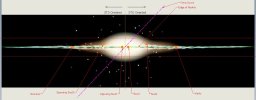 wiltshire13i.JPG73.6 KB · Views: 59
wiltshire13i.JPG73.6 KB · Views: 59 -
 wiltshire13m.JPG65.1 KB · Views: 27
wiltshire13m.JPG65.1 KB · Views: 27 -
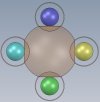 wiltshire13l.JPG48.2 KB · Views: 30
wiltshire13l.JPG48.2 KB · Views: 30 -
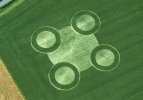 1997_07_06_headbourne-worthy-hampshire-wheat-35mm-neg.jpg650.3 KB · Views: 58
1997_07_06_headbourne-worthy-hampshire-wheat-35mm-neg.jpg650.3 KB · Views: 58 -
 wiltshire13k.JPG49 KB · Views: 55
wiltshire13k.JPG49 KB · Views: 55 -
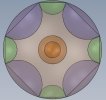 wiltshire13j.JPG43.9 KB · Views: 53
wiltshire13j.JPG43.9 KB · Views: 53 -
 1997_06_21_morestead-hampshire-wheat-35mm-neg.jpg692.5 KB · Views: 47
1997_06_21_morestead-hampshire-wheat-35mm-neg.jpg692.5 KB · Views: 47

